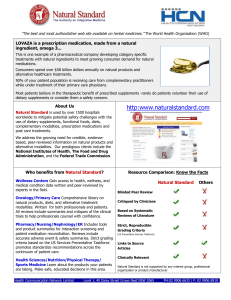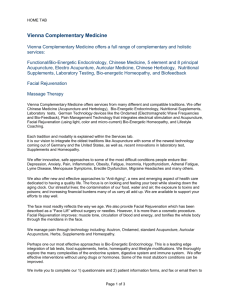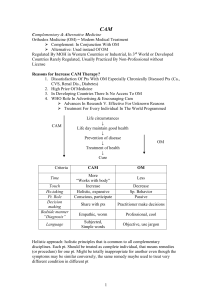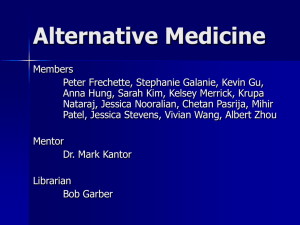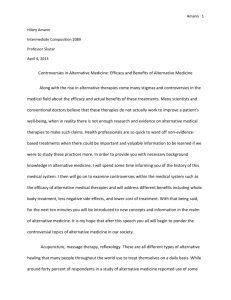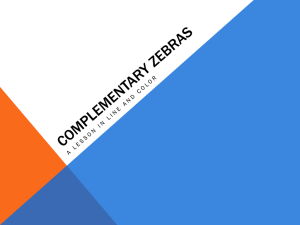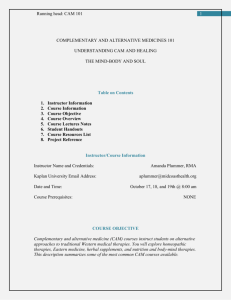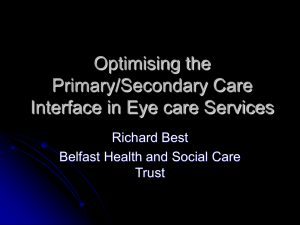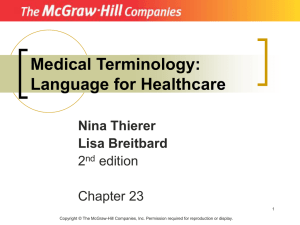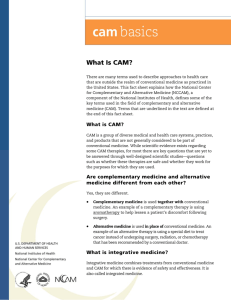Alternative & Complimentary Medicine in ophthalmology
advertisement
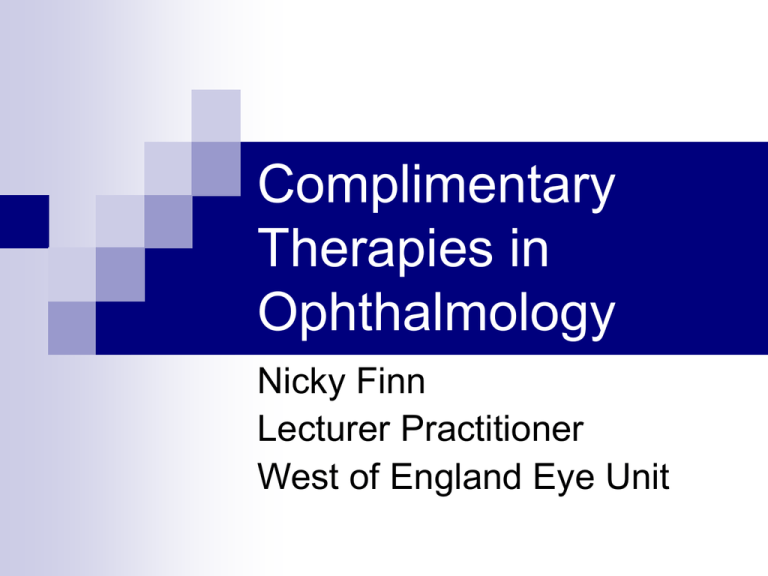
Complimentary Therapies in Ophthalmology Nicky Finn Lecturer Practitioner West of England Eye Unit What are CAM’s ? ‘Diagnosis, treatment and /or prevention which complements mainstream medicine by contributing to a common whole, by satisfying a demand not met by orthodoxy or by diversifying the conceptual frameworks of medicine.’ Ernst & Cassileth(1998) Where do healthcare practitioners stand legally with regard to CAM’s They are mostly legal but practitioners are not regulated. They can be freely prescribed in the UK, but not in all European countries. They are considered drugs/treatments and it is therefore now viewed as good practice to include them in history taking when assessing patients. They are not without side effects and contra indications and these should be considered when carrying out history taking & assessment. Unconventional treatments of the past. Protein shock (milk, serum or vaccine) Biogenic stimulation with tissue such as placenta injected subconjunctivally for a host of incurable eye conditions. Cobra venom injected for macular degeneration. Past physical treatments for eye conditions Environmental therapy for the affluent sick. Ocular massage. Blood letting. Thermotherapy. Electrotherapy- a faradic current used to create an “electric eye bath” creating a “local gymnastic effect” on the sufferer ! Pre Christian era Illness blamed on malignant spirits, devils, superstition and mystic rites. Treatment was threw: Recital of complex incantations. Prophylactic measures to prevent the devil entering the eye however often more vile than the affliction. By th 7 century BC Plants extracts & minerals applied as powders blown into the eye. OR Ointment mixed with water, milk, wine or oil. The role of the priest -magician & physician diverged as therapeutics became more elaborate. Dry eye treatment as per Assyrian recipe Local application of Gall bladder of a freshly disembowelled frog mixed with raw onion. The modern day approach to CAM in ophthalmology is holistic Diet. Nutritional supplements, antioxidants & vitamins. Physical exercise. Treatments used as CAM’s in ophthalmology Acupuncture Faith healing Cannabis Dietary supplements Herbal remedies Homeopathy Acupuncture Acupuncture is described as a Chinese medical system which aims to diagnose illness and promote health by stimulating the body’s selfhealing powers. Downey (2001) Acupuncture Designed to correct the imbalance of energy flow along specific channels throughout the body. Used to treat & alleviate: Dry eyes Myopia Paralytic strabismus Retinitis pigmentosa Optic atrophy Iritis Conjunctivitis Cataracts Herbal Medicine Herbal medicine is described as the use of whole plant material by trained practitioners to promote recovery from disease and to enable healing to take place. Busby (2001) Cannabis Used to try and treat glaucoma No scientific evidence. Initial studies suggested IOP lower 3-4 hours after administration. Needs to be used about 5 times a day. No effect if used topically. Side effects: Increase heart rate, lower BP this may compromise optic nerve perfusion. Smoking increased cancer risk with nicotine. Euphoria! Bilberry Pharmacological action: Antioxidant Believed to: Improve night vision. Contra-indications: Potential to increase anticoagulant action. Gingko Biloba Comes from the Maidenhair tree. Pharmacological action: Inhibits blood clotting Improves central & peripheral blood flow Antioxidant activity. Believed to: Aid mental alertness Improve visual acuity in ARMD. Contra-indications: Combined with aspirin maybe hazardous & associated with pupillary margin haemorrhage. Ginseng Contains over 20 constituents: Vitamins A B1,B2 Calcium Titanium Strontium Several steroids Believed to: Provide ‘atmospheric energy to the 5 viscera Quieting of animal spirits Brightening of the eye Improvement of vision Suggested therapeutic monitoring of: Blood glucose Potential interaction with other medications: Increased action of heart medications. Increase anti-diabetic effect of anti -diabetic medication. Increase in plasma levels with oral contraception. Increasing anticoagulation N-Acetyl Cysteine (NAC) This is a specially modified form of the dietary amino acid, cysteine. This is thought to help loosen the thick crusty secretions that block oil-secreting glands if taken orally. In a study by Yalcin et al(2002) This studied the effect of N-Acetyl Cysteine on 50 patients with chronic posterior blepheritis and found significant improvement. The limitations of this study are its small size and the fact it was not a blind study. An interesting study but more research would be advisable before it is recommended. Other supplements which have been suggested as helpful in blepheritis: Flax oil (omega 3 fatty acid) Chamomile Calendula However using herbal remedies in the eye is described as “risky” and not suitable without medical supervision by The Natural Pharmacist (2003) Dietary supplements Nutritional supplements in the form of : Trace elements Antioxidants Vitamins Antioxidant vitamin and zinc supplementation One systematic review found modest evidence from one large RCT that, in people with early to late age related macular degeneration, antioxidant vitamins plus zinc supplements reduced the risk of progression and vision loss over 6 years compared with placebo. Homeopathy Homeopathy is described as a 200 year old system of medicine based on the Law of Similars (let like be cured by like). Haehl(1985) Homeopathy Micro doses of substances like: Natrum muriaticum – for heavy eye lid & headaches Ruta graveolens –for eye strain from over use. Euphrasia – eyes inflamed watering and unable to bear light Pulsatillia - conjunctivitis Apis Mel – eyelids swollen particularly the lower eyelids Argentum Nit – conjunctivitis with headaches Ernst (2003) CAM’s should not be treated differently to any other area of health care when testing their effectiveness, safety and value to the patient Nurses must consider the ethical principles Autonomy - which allows the patient to make choices in treatment. Non-maleficence - which means not harming patients when providing treatment. Beneficence - using safe and effective treatments and discussing with patients research about the possible harm and benefits. Justice - ensuring all patients have equal access to treatments. References Astbury, N.(2001) Alternative eye care. British Journal of Ophthalmology. 85,7,767-769. • Dimond, B.(1998) The legal aspects of complementary therapy practice. A guide for health care professionals. Churchill Livingstone.London. • Ernst,E ; Pittler, M; Stevenson, C & White, A (2001) The Desktop Guide to Complementary & Alternative Medicine an evidence based approach. Mosby. • Ernst, E & Cassilith, B. (1998) The prevalence of complementary/alternative medicine in cancer – a systematic review. Cancer. 83,1,32-36. • Fearon, J. (2001) Complementary therapy. Primary Health care.11,10,33-36. • Haehl, R.(1985) Samuel Hahnemann.His life and works.B.Jain, New Delhi, India,2 vol. • Rhee,D;Spaeth,M; Myers,J;Steinmann,M;Augsburger,J; Shatz,L;Terebut,A Ritner,J & Katz,L.(2002) Prevalence of the use of complementary & alternative Medicine for glaucoma.Ophthalmology.109,438-443. • Downey,S and Busby, H. in Rankin-Box, D (2001) The nurses handbook of complementary therapies. 2nd Edition. Bailliere Tindall. Internet sites http://www.internethealthlibrary.com http://www.fihealth.org.uk •

